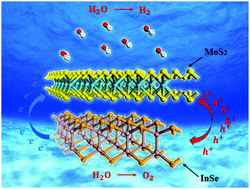Retracted Article: Using van der Waals heterostructures based on two-dimensional InSe–XS2 (X = Mo, W) as promising photocatalysts for hydrogen production
Abstract
The theoretical construction of two-dimensional materials for the generation of van der Waals heterostructures is extensively used as a fascinating means for designing novel nanoelectronic and optoelectronic devices. Herein, using first-principles calculations, we systematically investigate the new InSe–XS2 (X = Mo, W) vdW heterojunction. Our results indicate that InSe–MoS2 and InSe–WS2 vdW heterojunctions possess direct band gaps of 1.48 and 1.421 eV, respectively. The reduction/oxidation potentials of water are within the valence-band maximum (VBM) and the conduction-band minimum (CBM) (VBM/CBM) of the InSe–XS2 (X = Mo, W) vdW heterojunctions, showing significant potential for photocatalytic applications. The band gaps and band edge positions of the computed heterojunctions in a neutral environment meet the requirement for water splitting. Moreover, the results for InSe–XS2 (X = Mo, W) vdW heterojunctions show an enhanced optical absorption and suitable CBM positions with respect to the water potential reduction. Our results indicate that InSe–XS2 (X = Mo, W) heterojunctions have stronger driving force for the hydrogen evolution reaction. In addition, biaxial strain can effectively modify the band gap values. Outstanding visible and near-infrared light absorption abilities from ∼400 to around 1400 nm guide the InSe–MoS2 vdW heterojunction to promising applications in photovoltaics.



 Please wait while we load your content...
Please wait while we load your content...